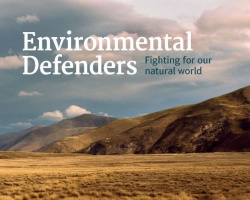New Research Confirms Dolphins Are Disappearing
New Research Confirms Dolphins Are Disappearing
Newly published research from the Universityof Otagoconfirms that Hector’s dolphins are disappearing more than ten times faster than populations can sustain.
Associate Professors Liz Slooten and Steve Dawson applied a standard method used to assess whether human induced mortality is causing the decline of marine mammal populations to Hector’s and Maui’s dolphins. The technique was developed by the US National Marine Fisheries Service and calculates the level of impact beyond which populations will decline - the Potential Biological Removal (PBR).
Care for the Wild’s chief executive Dr Barbara Maas says, “The results of this newly published research closely match similar models used by NIWA, the fishing industry and earlier analyses by the University of Otago and once again confirm the utterly indefensible death toll fishing imposes on the world’s rarest dolphin species. It doesn’t take a biologist to understand that killing Hector’s dolphins more than ten times faster than they can breed is unsustainable and will lead to extinction. With a mere 111 Maui’s dolphins left in the world, there isn’t very far to go either.”
Hector’s and Maui’s dolphin numbers are severely depleted. Hector’s dolphins take years to reach maturity, breed very slowly and only give birth to one calf. Populations are therefore extremely vulnerable. The death of even one animal a year, whether as a result of fishing, pollution, marine mining, disease or boat strikes spells the end for most populations. The figure for the species as a whole is less than ten animals a year.
“If Hector’s dolphins are to recover, fishing related mortality must be kept well below these limits”, says Dr Maas. “But according to NIWA, each year 110 to 150 Hector’s dolphins die in commercial gill nets alone.” As a result, Hector’s dolphin populations have dwindled by more than two thirds since the 1970s. Maui’s dolphins, the North Islandsubspecies of Hector’s, are even worse off. More than 90% have already been lost as a result of net entanglements.”
Full protection against human impacts, including commercial and recreational gill-netting and trawling would allow dolphin numbers to recover to about 15,000 over the next 50 years.
“Every analysis to date has shown that if Hector’s dolphins are to be saved, gillnets need to be removed from their habitat. Although the Government announced new fishing restrictions to improve Hector’s and Maui’s dolphin protection against fishing earlier in the year, these measures don’t go far enough and won’t ensure population recovery.”
The scientific community, represented by the Society for Marine Mammology, the IUCN’s Cetacean Specialist Group and more than 170 international conservation organisations have urged the Government to fully protect Hector’s and Maui’s dolphins from fishing nets.
“Although the fishing industry played an active role in the research and public consultation that led to the compromise measures agreed by the Government, it is now contesting the new regulations in court”, says Care for the Wild’s Dr Maas. This wastes valuable time and resources and more dolphins will die as a result.
New Zealandholds this species in trust for the rest of the world. Unless New Zealandprotects Hector’s and Maui’s dolphins will be lost to us forever.
ENDS


 Environmental Defence Society: Groundhog Day, New Book Shows History Is Repeating Itself
Environmental Defence Society: Groundhog Day, New Book Shows History Is Repeating Itself NZEI Te Riu Roa: Mandated Single Approach To Reading Will Not Work
NZEI Te Riu Roa: Mandated Single Approach To Reading Will Not Work The Conversation: Could The School Phone Ban Work?
The Conversation: Could The School Phone Ban Work? Public Health Communication Centre: To Avoid A Measles Epidemic, Aotearoa Must Close The ‘Immunity Gap’
Public Health Communication Centre: To Avoid A Measles Epidemic, Aotearoa Must Close The ‘Immunity Gap’ Heritage New Zealand: Kid-friendly Archaeology Resource Kit Launched As Part Of Archaeology Week
Heritage New Zealand: Kid-friendly Archaeology Resource Kit Launched As Part Of Archaeology Week Tatai Aho Rau Core Education: Cyber Skills Programme For Tamariki Recognised At Māori Language Awards
Tatai Aho Rau Core Education: Cyber Skills Programme For Tamariki Recognised At Māori Language Awards